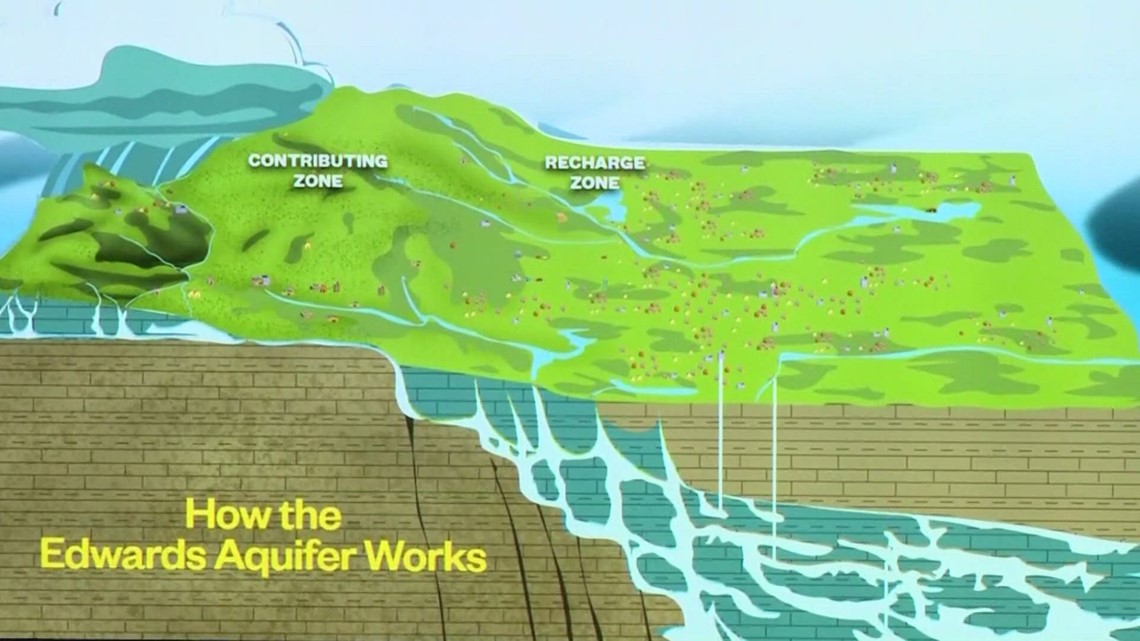‘We need rain’: Edwards Aquifer drops to lowest level in nearly a decade
'We need rain': Edwards Aquifer drops to lowest level in nearly a decade KENS5.com


About the Drought Conditions in South Texas

Approximately 2.5 million people in South Texas rely on the aquifer for drinking water and everyday use. The current record-setting streak of heat is exacerbating the drought conditions in the region, leading to cracked creek beds, low lakes, and reduced flow in the Guadalupe and Comal rivers, indicating a decline in surface water availability.
The Edwards Aquifer Authority (EAA) Implements Stage 4 Restrictions
The Edwards Aquifer Authority (EAA), responsible for managing the aquifer, has recently entered Stage 4 restrictions as of the end of July. This means that permit holders, including irrigators, agricultural users, industrial users, and water providers, are required to reduce their water pumping from the Edwards Aquifer by approximately 40%. The EAA has a total of 1,200 permit holders who must determine how to reduce their water usage to meet the requirements set by the authority.
Impact on the Region
The aquifer serves as a vital water source for about 2.5 million people across eight counties in South Texas. While some water providers may have diverse water portfolios, the majority still rely on the Edwards Aquifer for their water supply. The aquifer’s water level has dropped to its lowest point since 2014, highlighting the severity of the current drought conditions.
Sustainable Development Goals (SDGs)
- Goal 6: Clean Water and Sanitation – The declining water availability in the aquifer poses a threat to achieving this SDG, as it directly impacts the access to clean drinking water for millions of people in the region.
- Goal 13: Climate Action – The record-setting heat and prolonged drought conditions in South Texas are clear indicators of the urgent need for climate action to mitigate the effects of climate change.
- Goal 15: Life on Land – The restrictions implemented by the EAA aim to protect endangered species in the Comal and San Marcos springs, emphasizing the importance of preserving biodiversity and ecosystems.
Challenges and Recommendations
- The EAA’s water cap and proactive management approach serve as a model for groundwater conservation. However, other groundwater conservation districts in Texas lack resources and tools to effectively manage groundwater. It is crucial for the state to invest in data, science, and modeling to ensure sustainable groundwater management.
- The current drought conditions have led to wells running dry and reduced spring flow, such as Jacob’s Well. Addressing these challenges requires immediate action and long-term planning to ensure water security for communities.
Potential Relief through Rainfall
The Edwards Aquifer is highly responsive to rainfall and drought conditions. Even a small amount of rain can have a significant impact on replenishing the aquifer. The National Weather Service (NWS) forecaster Jason Runyen predicts a potentially wetter than normal winter, offering hope for relief from the drought conditions in the coming months.
SDGs, Targets, and Indicators
| SDGs | Targets | Indicators |
|---|---|---|
| SDG 6: Clean Water and Sanitation | 6.4: By 2030, substantially increase water-use efficiency across all sectors and ensure sustainable withdrawals and supply of freshwater to address water scarcity and substantially reduce the number of people suffering from water scarcity | Indicator 6.4.2: Level of water stress: freshwater withdrawal as a proportion of available freshwater resources |
| SDG 13: Climate Action | 13.1: Strengthen resilience and adaptive capacity to climate-related hazards and natural disasters in all countries | Indicator 13.1.1: Number of deaths, missing persons, and directly affected persons attributed to disasters per 100,000 population |
1. Which SDGs are addressed or connected to the issues highlighted in the article?
SDG 6: Clean Water and Sanitation
The article discusses the worsening drought conditions in South Texas, which directly relates to the issue of water scarcity. SDG 6 aims to ensure availability and sustainable management of water and sanitation for all.
SDG 13: Climate Action
The article mentions the record-setting streak of heat, which exacerbates the drought conditions. This highlights the need for climate action to strengthen resilience and adaptive capacity to climate-related hazards.
2. What specific targets under those SDGs can be identified based on the article’s content?
Target 6.4: By 2030, substantially increase water-use efficiency across all sectors and ensure sustainable withdrawals and supply of freshwater to address water scarcity and substantially reduce the number of people suffering from water scarcity.
The article mentions that the Edwards Aquifer Authority (EAA) has entered Stage 4 restrictions, requiring permit holders to reduce their water pumping from the aquifer by about 40%. This reduction in water usage aims to address water scarcity.
Target 13.1: Strengthen resilience and adaptive capacity to climate-related hazards and natural disasters in all countries.
The article discusses the need for rain to alleviate the drought conditions. Strengthening resilience and adaptive capacity to climate-related hazards, such as droughts, is crucial to address the impacts of climate change.
3. Are there any indicators mentioned or implied in the article that can be used to measure progress towards the identified targets?
Indicator 6.4.2: Level of water stress: freshwater withdrawal as a proportion of available freshwater resources.
The article mentions that the aquifer has dropped to its lowest level since 2014, indicating increased water stress due to excessive freshwater withdrawal.
Indicator 13.1.1: Number of deaths, missing persons, and directly affected persons attributed to disasters per 100,000 population.
While not explicitly mentioned in the article, the worsening drought conditions can lead to various impacts, such as agricultural losses and decreased water availability for communities. These impacts can indirectly affect the well-being and livelihoods of the population.
4. Table: SDGs, Targets, and Indicators
| SDGs | Targets | Indicators |
|---|---|---|
| SDG 6: Clean Water and Sanitation | 6.4: By 2030, substantially increase water-use efficiency across all sectors and ensure sustainable withdrawals and supply of freshwater to address water scarcity and substantially reduce the number of people suffering from water scarcity | Indicator 6.4.2: Level of water stress: freshwater withdrawal as a proportion of available freshwater resources |
| SDG 13: Climate Action | 13.1: Strengthen resilience and adaptive capacity to climate-related hazards and natural disasters in all countries | Indicator 13.1.1: Number of deaths, missing persons, and directly affected persons attributed to disasters per 100,000 population |
Behold! This splendid article springs forth from the wellspring of knowledge, shaped by a wondrous proprietary AI technology that delved into a vast ocean of data, illuminating the path towards the Sustainable Development Goals. Remember that all rights are reserved by SDG Investors LLC, empowering us to champion progress together.
Source: kens5.com

Join us, as fellow seekers of change, on a transformative journey at https://sdgtalks.ai/welcome, where you can become a member and actively contribute to shaping a brighter future.







